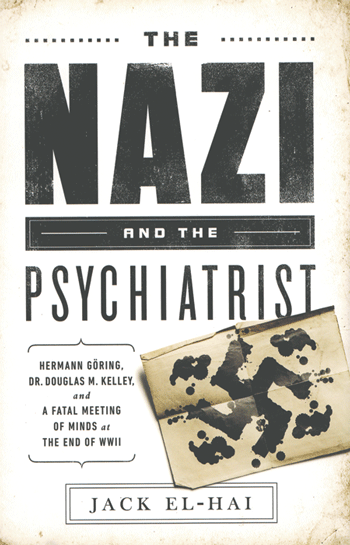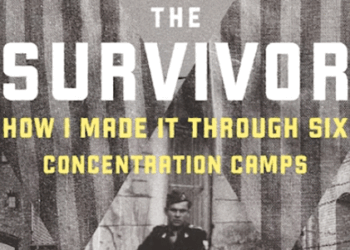The Nazi and the Psychiatrist: Hermann Göring, Dr. Douglas M. Kelley and a Fatal Meeting of the Minds at the End of WW II, by Jack El-Hai, Public Affairs, 304 pages, $27.99
Reviewed by NEAL GENDLER
Tales of two men whose high potential led to similar self-destruction mingle in Minneapolis author Jack El-Hai’s engaging account of the psychiatrist who examined and spent hours conversing with the imprisoned No. 2 Nazi: Hermann Göring.
On Aug. 4, 1945, Major Douglas M. Kelley, a prewar supervisor of psychiatric hospitals, was assigned to oversee the mental care of high-ranking Nazis confined in Luxembourg — soon to be transferred to Nuremberg for the first and most famous war-crimes trial.
With fabulous luck, El-Hai, author of The Lobotomist, found that Kelley’s son had saved his father’s voluminous collection of patient observations, interview notes and reports, providing El-Hai firsthand evaluations of the 22 top prisoners. The result, The Nazi and the Psychiatrist, is a smoothly written, attention-grabbing book conveying educated insights into leading officials of that monstrous regime. Oddly, photos lack one of Kelley in the prison or even in the army.
Kelley’s army job was to keep the prisoners mentally fit for trial. His private quest was to seek a common flaw — a willingness to commit evil — that might identify others with similar tendencies.

Ultimately, he found none, even using then-novel Rorschach tests, concluding that “men whose personalities fell within the normal parameters had set in motion the Nazi outrages,” El-Hai says. But they varied greatly, from crazed, suicidal labor director Robert Ley to Grand Admiral Karl Dönitz, whom Kelley called “a leader of great stature and a most competent man.”
Göring was the most important and interesting of them all.
Kelley had no experience with war criminals and little expertise in withdrawing addicts from drugs — Göring’s luggage included 20,000 pills — but he was no beginner. He’d successfully treated combat neurosis and combat exhaustion, and had supervised treatment of all Army psychiatric cases in Europe. He began to study the Nazis “as a biologist might scrutinize animals confined in laboratory cages,” El-Hai says.
Kelley weaned Göring from the paracodeine pills he gobbled like candy, and got him to drop 60 pounds in five months.
Most prisoners welcomed Kelley’s visits to their barren, solitary cells, conversing in English or translation, trusting him with information they withheld from interrogators.
Julius Streicher, publisher of the Nazi newspaper Der Stürmer (its grotesque slanders of Jews live on in Arab propaganda), had established cordial relations with translator Sergeant Howard Triest, a blue-eyed blond he characterized as “the perfect Nordic.” Streicher told Triest he could smell a Jew a mile away and suspected Kelley was Jewish. In fact, the Jew was Munich-born Triest.
Göring was “the most outstanding personality in the jail because he was intelligent,” Kelley wrote, calling him “a powerful, dynamic individual,” both admirable and sinister. But Göring “possessed the most undiluted self-centeredness Kelley had ever experienced,” El-Hai says. “Kelley was astonished that such a clearly intelligent and cultured man so blatantly lacked a moral compass.”
Less impressed was Lieutenant Gustave Gilbert, a psychologist and German-speaking Jew who found Göring “smart and cynical, but no genius,” depressed and depraved, El-Hai says.
Kelly departed before the end of the trial. El-Hai says all defendants but Rudolf Hess thanked him for his attention, and Göring “broke down and wept.” Kelley’s judgment that Göring would shout “Heil Hitler” at the gallows proved wrong. Göring, denied his requests for a firing squad, refused to face the humiliation of hanging and the night before bit into his hidden vial of cyanide.
Back home, Kelley wrote 22 Cells in Nuremberg and headed in a new direction, combining psychiatry and criminology. He consulted for police, lectured, and took a full professorship in University of California-Berkeley’s criminology department.
Kelley’s “ravenous curiosity” led to a frenzied professional life that included a television series about criminal behavior. The pressure may have provoked inner demons, leading to drinking and rages. His last was Jan. 1, 1958, when a kitchen blowup with his wife led to his standing at the top of the stairs howling, “I don’t have to take this anymore” and swallowing potassium cyanide. He was dead at age 45.
***
Neal Gendler is a Minneapolis writer and editor.
(American Jewish World, 9.13.13)




















